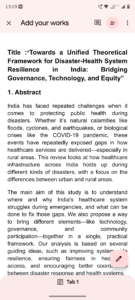by Bhavya Gupta
As individuals age, they face different challenges of ageing, especially the deepening of loneliness in their population. This article focuses specifically on the geropsychological viewpoint of ageing and loneliness. Various factors contributing to loneliness were estimated to explain the extent to which people in old age feel socially isolated, based on the different types of loneliness. The different variables for explanation were drawn from socio-emotional selectivity theory and the cognitive perspective on loneliness. Major life transitions, psychological factors like cognition in old age, poor health and lifestyle among the elders are seen as significant contributors. Various intervention strategies such as coping techniques, community-based engagements and technology-driven solutions are presented as mitigation strategies for loneliness. The article aims to focus on views to understand loneliness and the promotion of social participation for the older population.
Introduction
According to Shukla (2023), ageing can be defined as the progressive deterioration of physiological functions and increased vulnerability to diseases. According to the American Psychological Association (2018), Gero psychology aims to deal with and enhance mental health in the elderly via different psychological services. The challenges of ageing include health, social, and economic factors. The other associated problems are multimorbidities and comorbidities, increased anxiety and depression due to social isolation, caregiving gaps and negative discriminating stereotypes against the elderly (Kovalev, 2022).
Researchers like Pascalidis and Bathelt (2024), indicate loneliness as a risk factor for diseases like depression, anxiety and premature mortality. By focusing on the determinants and mitigating factors of loneliness one can inform effective interventions such as tailored support programs that enhance social engagement and self-esteem among the elderly (Satorres et al., 2024; McDaid & Park, 2023).
Understanding Loneliness in Old Age
Loneliness is an affective and cognitive discomfort or uneasiness caused by being or feeling alone or otherwise solitary (APA, 2018). Old-age loneliness damages well-being, physical and mental health, and mortality rates (Dahlberg et al., 2022). These claims are consistent with a resource-based perspective on loneliness (Tesch-Römer & Huxhold, 2019) and are comparable to the findings of a meta-analysis, which revealed that both income and education are associated with loneliness, with income having the greatest influence (Pinquart & Sörensen, 2003). According to a study by Pikhartova and colleagues (2016), feeling older is associated with increased loneliness suggesting that older adults’ subjective perceptions of loneliness and ageing should be investigated further.
Types of Loneliness
Based on distinct relational deficits and experiences, loneliness can be divided into three types:
Emotional Loneliness. It is caused by the absence of intimate relationships, such as a close friend or partner, resulting in feelings of isolation and longing for connection which further can harm mental health (Barletta, 2022; Jackson, 2024).
Social Loneliness. Loneliness in social terms occurs when people feel isolated from their community circles and they lack a sense of belonging and friendships this further is linked to broader societal changes such as individualism and urbanization which further weaken communal bonds (Barletta, 2022; Cyriac, 2022).
Existential Loneliness. It is the isolation that stems from realizing one’s inherent aloneness, lack of purpose or connection to something greater in life which is accompanied by feelings of emptiness and meaninglessness (Tilburg, 2021; Schoenmakers & Tromp, 2022).
Understanding these types of loneliness is critical when examining the factors that contribute to them in old age.
Factors contributing to Loneliness in Old Age
According to Socio-emotional selectivity theory (SST; Carstensen et al., 2021), age brings the valuation of emotionally meaningful relationships, and loneliness is a consequence when it subsides in old age. Loneliness in older adults is caused by several key factors, including:
Life Transitions: Major transitions in an individual’s life can create a void or feeling of isolation and further loneliness. In old age, retirement and bereavement frequently cause significant changes in social networks, leading to isolation and loneliness (Kim & Chey, 2023).
Psychological Factors: Loneliness is further multiplied by failing cognitive skills since elderly people cannot even maintain relationships as they become old (Park et al., 2022; Kulaieva, 2022).
Health: Poor health limits senior citizens from participating in specific activities, thereby hindering them from expanding their social lives (Park et al., 2022). Health issues can limit mobility and social participation, further isolating elders (Lee et al., 2024).
Other Factors: Other determinants of loneliness among this age group are most of whom live alone. For instance, research indicates that 73.2% of stayers living alone, develop loneliness (Lee et al., 2024).
Intervention Strategies
Effective coping techniques and intervention strategies including social support systems, technology-based and community-based interventions can help reduce isolation among the elderly. Group-based interventions such as clubs volunteering and community events can reduce loneliness by fostering social interaction and shared experiences (Shekelle et al., 2024; Sivakumar et al., 2024)
The elderly are increasingly accessing digitalisation and AI-based interventions due to advancements in technology. Web-based cognitive behavioural therapy (CBT) is designed for the elderly and aims to enhance engagement and efficacy simultaneously. Training seniors to use technology can improve communication with loved ones and reduce loneliness (Dworschak et al., 2024; Shekelle et al., 2024).
A multifaceted approach that includes mental health resources, meaningful activities, and supportive environments is required to address loneliness comprehensively (Patil & Braun, 2024; Fakoya et al., 2023). Personalised support services that encourage social participation have proven effective, particularly when they align with the participants’ interests (McDaid & Park, 2023).
Conclusion
Loneliness in old age remains a complex and multifactorial issue that impacts the mental, emotional and physical well-being of the older generation. As this article highlights, factors such as life transitions, cognitive decline, poor health and lifestyle changes contribute to the deepening of loneliness among the elders. By understanding emotional, social and existential loneliness- geropsychological insights can help address these challenges. Effective intervention strategies offer promising ways to reduce loneliness and improve the quality of life for the ageing population. Moreover, a comprehensive personalized approach that fosters social participation and addresses the unique needs of older adults is essential in mitigating the adverse effects of loneliness among elders.
References
Antsupov, A., & Kovalev, V. (2022). Social and psychological assessment of personnel. Litres.
Brinkhof, L. P., de Wit, S., Murre, J. M., & Ridderinkhof, K. R. (2023). Mitigating the Harmful Impact of Ageism among Older Individuals: The Buffering Role of Resilience Factors. Geriatrics, 9(1), 1.
Carstensen, L. L. (2021). Socioemotional selectivity theory: The role of perceived endings in human motivation. The Gerontologist, 61(8), 1188-1196.
Chey, J. (Ed.). (2023). Society Within the Brain: How Social Networks Interact with Our Brain, Behavior and Health as We Age. Cambridge University Press.
Dahlberg, L., von Saenger, I., Naseer, M., Lennartsson, C., & Agahi, N. (2024). National trends in loneliness and social isolation in older adults: an examination of subgroup trends over three decades in Sweden. Frontiers in Public Health, 12, 1444990.
Dworschak, C., Heim, E., Kuhn, N., Schwager, J., Tröster, A., & Maercker, A. (2024). User-centered development of an internet-based CBT intervention for the treatment of loneliness in older individuals. Internet Interventions, 35, 100720.
Fakoya, O. A., McCorry, N. K., & Donnelly, M. (2020). Loneliness and social isolation interventions for older adults: a scoping review of reviews. BMC public health, 20, 1-14.
FEASIBILITY, A. (2022). COGNITIVE FUNCTION AND LONELINESS AMONG OLDER ADULTS: DYNAMICS OF SOCIAL NETWORK AND PERCEIVED SOCIAL SUPPORT. Innovation in Aging, 6(S1), 825.
Franklin, A. S. (2022). Loneliness: The decline of cultural and everyday sources of belonging in contemporary societies. In Emotions in Culture and Everyday Life (pp. 81-98). Routledge.
Henning, G. (2019). Change and Continuity in Psychological Health Across the Retirement Transition. Interindividual Differences and Post-Retirement Adjustment.
Jackson, S. P. (2024). Phenomenologies of Loneliness: alone without you, alone without an us. Journal of Psychosocial Studies, 1(aop), 1-16.
Kulaieva, T. (2022). Theoretical model of experiencing loneliness in adulthood. Kyiv journal of modern psychology and psychotherapy, 4, 56-65.
Lee, J. H., Luchetti, M., Aschwanden, D., Sesker, A. A., Strickhouser, J. E., Terracciano, A., & Sutin, A. R. (2022). Cognitive impairment and the trajectory of loneliness in older adulthood: Evidence from the Health and Retirement Study. Journal of aging and health, 34(1), 3-13.
McDaid, D., & Park, A. L. (2023). Addressing Loneliness in Older People Through a Personalized Support and Community Response Program. Journal of Aging & Social Policy, 1-17.
Mohite, S. S., Momin, S. A., Niwate, S. A., Paliwal, R. M., Yadav, K. C., Shukla, S., & Bharati, D. K. (2023). The Science of Aging and Longevity.
Pascalidis, J., & Bathelt, J. (2024). The “central” importance of loneliness in mental health: A network psychometric study. International Journal of Psychology.
Patil, U., & Braun, K. L. (2024). Interventions for loneliness in older adults: a systematic review of reviews. Frontiers in Public Health, 12, 1427605.
Peplau, L. A. (2022). Loneliness. In Social problems and mental health (pp. 93-95). Routledge.
Pikhartova, J., Bowling, A., & Victor, C. (2016). Is loneliness in later life a self-fulfilling prophecy?. Aging & mental health, 20(5), 543-549.
Pinquart, M., & Sörensen, S. (2003). Risk factors for loneliness in adulthood and old age–a meta-analysis. Nova Science Publishers.
Schoenmakers, E. C., & Tromp, R. H. (2022). Social, emotional and existential loneliness among nursing home residents with somatic problems. Tijdschrift Voor Gerontologie en Geriatrie, 53(2).
Shekelle, P. G., Miake-Lye, I. M., Begashaw, M. M., Booth, M. S., Myers, B., Lowery, N., & Shrank, W. H. (2024). Interventions to reduce loneliness in community-living older adults: a systematic review and Meta-analysis. Journal of General Internal Medicine, 39(6), 1015-1028.
Sivakumar, P. T., Harbishettar, V., Pandey, N. M., & Tiwari, S. C. (2024). Clinical practice guidelines for promoting mental health and well-being of older adults: A special focus on strategies for coping with social isolation and loneliness. Indian Journal of Psychiatry, 66(Suppl 2), S331-S337.
Van Tilburg, T. G. (2021). Social, emotional, and existential loneliness: A test of the multidimensional concept. The Gerontologist, 61(7), e335-e344.
VandenBos, G. R. (2007). APA dictionary of psychology. American Psychological Association.






